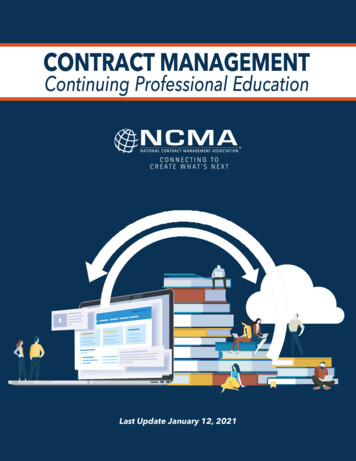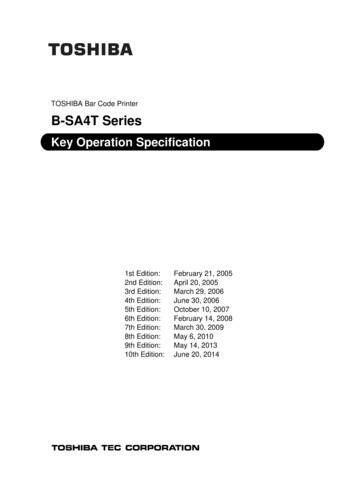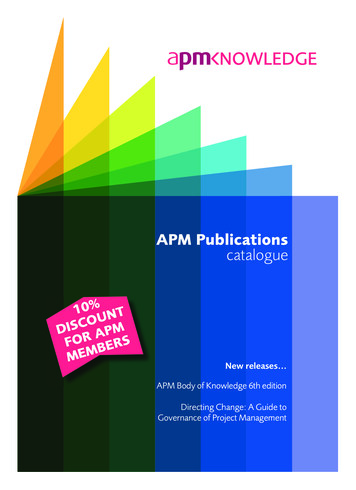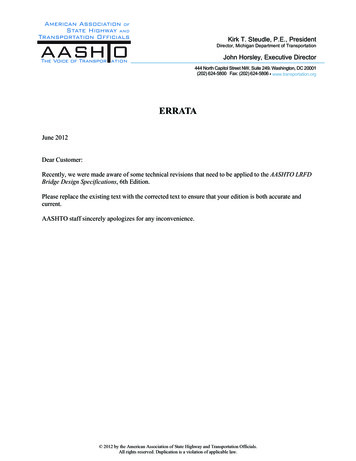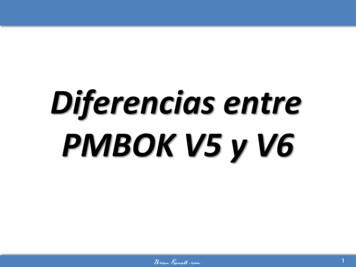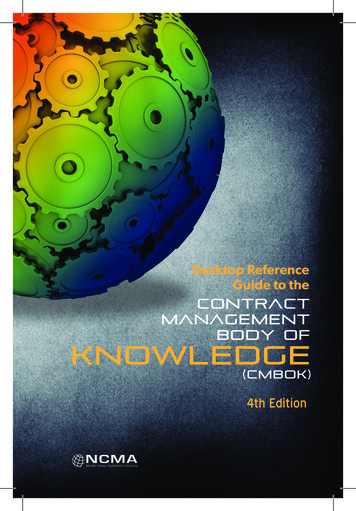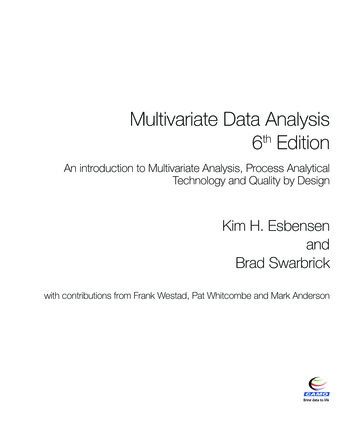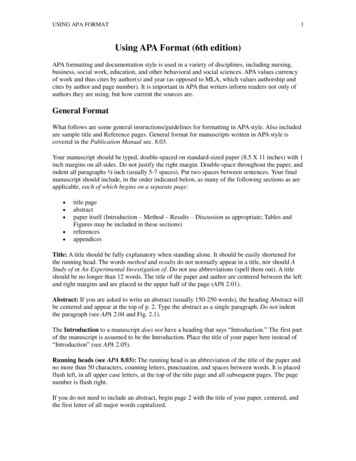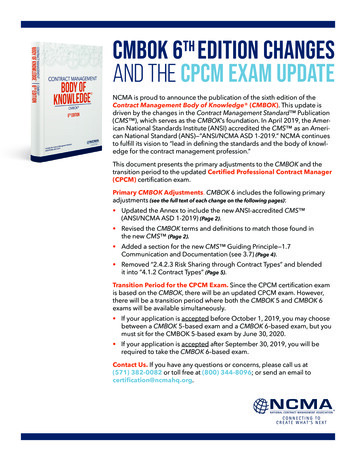
Transcription
CMBOK 6 edition changesand the CPCM exam updatethNCMA is proud to announce the publication of the sixth edition of theContract Management Body of Knowledge (CMBOK). This update isdriven by the changes in the Contract Management Standard Publication(CMS ), which serves as the CMBOK’s foundation. In April 2019, the American National Standards Institute (ANSI) accredited the CMS as an American National Standard (ANS)—”ANSI/NCMA ASD 1-2019.” NCMA continuesto fulfill its vision to “lead in defining the standards and the body of knowledge for the contract management profession.”This document presents the primary adjustments to the CMBOK and thetransition period to the updated Certified Professional Contract Manager(CPCM) certification exam.Primary CMBOK Adjustments. CMBOK 6 includes the following primaryadjustments (see the full text of each change on the following pages): Updated the Annex to include the new ANSI-accredited CMS (ANSI/NCMA ASD 1-2019) (Page 2). Revised the CMBOK terms and definitions to match those found inthe new CMS (Page 2). Added a section for the new CMS Guiding Principle—1.7Communication and Documentation (see 3.7) (Page 4). Removed “2.4.2.3 Risk Sharing through Contract Types” and blendedit into “4.1.2 Contract Types” (Page 5).Transition Period for the CPCM Exam. Since the CPCM certification examis based on the CMBOK, there will be an updated CPCM exam. However,there will be a transition period where both the CMBOK 5 and CMBOK 6exams will be available simultaneously. If your application is accepted before October 1, 2019, you may choosebetween a CMBOK 5–based exam and a CMBOK 6–based exam, but youmust sit for the CMBOK 5-based exam by June 30, 2020. If your application is accepted after September 30, 2019, you will berequired to take the CMBOK 6–based exam.Contact Us. If you have any questions or concerns, please call us at(571) 382-0082 or toll free at (800) 344-8096; or send an email tocertification@ncmahq.org.
CMBOK 6th Edition: Changes from CMBOK 5ADDED: Contract Management Standard (CMS ) Offer, Acceptance,Now part of the CMBOK, the ANSI-accredited CMS can bedownloaded from NCMA’s website: Consideration, and The intent to create a legal ification/contract-management-standard.For a contract to be valid, both parties must indicate that they agreeto the terms. For a contract to be binding, it must be for a legal purpose and it can only be made by parties who are competent.deliverableADDED OR REVISED: Terms and definitions inCMBOK 6:A tangible or intangible good or service delivered to fulfill all orpart of a contract.ensure qualityThe following terms and definitions were revised or added to theCMBOK Lexicon:This competency is in the post-award life cycle phase of contractmanagement, and it is in the “perform contract” domain. It is theprocess of:category managementA means of large, diverse organizations to purchase like a singleenterprise. Its intent is to eliminate redundancies, increase efficiency, and deliver more value and savings from the organization’spurchasing programs. It involves: Planning for contract performance delivery and monitoring, and Inspecting and accepting contract performance.The value added by this process is ensuring the delivered product orservice meets the specifications, terms, and conditions of the contract. Identifying core areas of spend; Collectively developing heightened levels of expertise;leadership Leveraging shared best practices; and Providing acquisition, supply, and demand managementsolutions.Varies from person to person and situation to situation. Whenviewed from the perspective of the “leader to the follower,”leadership can be described as the ability to influence people andsituations to achieve organizational goals. Competency is basedon the cumulative effect of competence, character, collaboration,and vision.close out contractThis competency is in the post-award life cycle phase of contractmanagement, and it is in the “close contract” domain. It is theprocess of ensuring:When viewed from the “follower to the leader,” leadership is agift a follower bestows on a person who: All performance has been accomplished, Final contractor performance has been evaluated, Advocates for our competence (professional development), Final payment has been made, and Validates our character (beliefs and values), The contract has been reconciled. Encourages collaboration (high-trust relationships), andThe value added by this process is the completion, delivery, andacceptance of the contract requirement(s) in accordance with theterms and conditions of the contract. Inspires vision (a clear pathway to success).closed contractmanage disagreementsA contract of which:This is in the award life cycle phase of contract management,and it is in the “form contract” domain. Manage disagreementsis the process of resolving conflict between potential and actualcontracted parties. The value added by this process is the abilityto resolve issues related to the solicitation or source selectionprocess through informal and formal means. All performance has been accomplished, Final contractor performance has been evaluated, Final payment has been made, and The contract has been reconciled.This gift must be earned—and continuously re-earned—by theleader.manage disagreementscontract performanceThis is in the award life cycle phase of contract management,and it is in the “form contract” domain. Manage disagreementsis the process of resolving conflict between potential and actualcontracted parties. The value added by this process is the abilityto resolve issues related to the solicitation or source selectionprocess through informal and formal means.The execution of the terms of a contract. See “perform contract.”contract principlesThe fundamentals of contracting that all contract managers mustunderstand and apply. A contract results from:2
CMBOK 6th Edition: Changes from CMBOK 5perform contractan offer is in exploiting and increasing organizational strengthsand efficiencies in order to enhance marketplace positioning.This domain is in the post-award life cycle phase of contract management. It is the process of executing contract requirements,managing business relationships, ensuring quality, and managingchanges. The value added by this process is in: Monitoring risk and assessing its impact on contract performance, and Ensuring compliance with 1) contractual terms and conditionsand 2) contract technical requirements during contract performance up to contract closeout or termination.publication1.The placement of an advertisement in a newspaper, magazine, trade or professional journal, or any other printedmedium; or2.The broadcasting of an advertisement over radio or television.publication dateThe date an announcement or publication was published.plan negotiationspublishThis competency is in the award life cycle phase of contractmanagement, and it is in the “form contract” domain. It is theprocess of preparing for interaction between the buyer and sellerregarding all aspects of the offer and its terms, and often involvesclarifying requirements and parties requesting changes or consideration of an alternate approach that may be consistent with thesolicitation requirements. The value added by this process is thatboth parties work to find common ground or offer compromisesamong their differences in quantity, price, delivery, quality, orother factors.To make publicly known.quality assuranceThe buyer’s planned and systematic pattern of actions necessaryto provide adequate confidence that material, data, supplies, andservices conform to established technical requirements, and toachieve satisfactory performance. See “ensure quality.”quality control (QC)1.The seller’s process of measuring quality performance, comparing it with the standard, and acting on the difference. See“ensure quality.”2.All those tasks done within an organization to improve thequality of its output. This would include inspection systemsset up by a seller to monitor its own output at key intervals inthe contracting process.plan salesThis competency is in the pre-award life cycle phase of contractmanagement, and it is in the “develop offer” domain. It is theprocess of: Organizing pre-sales activities to develop customer relationsand market strategy, Understanding the marketplace, and Assessing competition.select sourceThis competency is in the award life cycle phase of contractmanagement, and it is in the “form contract” domain. It is theprocess of analyzing submitted offers in accordance with thesolicitation evaluation criteria to select the source that hasthe highest probability of satisfactory contract performance.The value added by this process is in mitigating buyer risk byselecting the offeror most likely to satisfactorily perform thecontract and assures the seller of a consistent and fair selectionprocess.The value added in sales planning is in understanding the customer’s near- and long-term requirements and determine the organization’s ability to successfully respond to a solicitation.plan solicitationThis competency is in the pre-award life cycle phase of contractmanagement, and it is in the “develop solicitation” domain. Itis the process by which efforts of all personnel responsible foracquiring a product or service are coordinated and integratedthrough a comprehensive plan for fulfilling the customer need ina timely manner at a reasonable cost. The value added is in developing a solicitation plan with the overall strategy for managingthe acquisition that includes elements such as:sound business judgmentA decision or determination, by a person with the authority to doso, that is made: In good faith; In a manner such that the decision-maker believes the decision to be competent, sensible, logical, valid, and in the bestinterests of the organization; With such care, including reasonable inquiry, as an ordinarilyprudent person in a like position would use under similarcircumstances; andprepare offer This competency is in the pre-award life cycle phase of contractmanagement, and it is in the “develop offer” domain. It is theprocess of the organization’s ability to execute the sales plan as itassembles an offer to win business. The value added in preparingSo as the decision can generally be deemed to be trustworthy and free from errors.strategic sourcing Assisting in defining the buyer’s requirements, Conducting relevant market research, Performing meaningful risk analysis, and Formulating the contracting strategy.The selection and management of suppliers with a focus onachieving the long-term goals of a business.3
CMBOK 6th Edition: Changes from CMBOK 5transparencyJustification for contract management actions should be in writingin a format that complies with applicable procedures. At a minimum, a written justification has three sections:The ability to be open and honest with no intent to deceive ormislead in any manner.ADDED: CMBOK 6: Guiding Principles—3.7 Communication and DocumentationThe following section was added to CMBOK 6:Communication between all affected parties must be exchangedand managed to maintain contract management effectiveness.Communication must:Minimize the effect of personal biases, Maximize the likelihood of accurate results, and Facilitate communication among affected parties.Contracts and the planning leading to a contract; Gestures, conduct, and verbal exchanges; Rationale used in decision-making and business judgment; Mutually agreed-upon expectations; Planned and unplanned events; Performance issues and accountability; Conflict and resolutions; Changes and solutions; Risk management and mitigation; Contract compliance and performance quality; and Knowledge gained and lessons learned.2.State the rationale why the decision is necessary(the circumstances), and3.State how the decision was made (the process).To justify the first decision, state the decision to deviate fromthe preferred method, state in detail the rationale for why it isnecessary to deviate from the competition policy, and describein detail how the contract management team went about makingthe decision including consideration of alternative methods.Contract managers facilitate communication through clearly writtendocumentation that is unambiguous and able to be understood.Where appropriate, documentation is exchanged and managedamong affected parties. Documentation is often prepared andretained in contract files to support determinations made and actionstaken. Examples of topics to document include, but are not limited to: State the decision,Some contract actions have multiple steps, each of which mustbe separately justified. A common example would be a non-competitive procurement when competition is the preferred method.In this example, it is typical to justify the decision not to compete,justify the source that has been selected, and justify the price.3.7 Communication and Documentation 1.To justify the second decision, state the name, location, and otherpertinent information of the source; state the rationale for why thisis the only source for the job; and describe in detail how the teamwent about determining that this particular source is capable,competent, experienced, etc.To justify the third decision, state that the price is fair and reasonable, state the rationale for why that determination is necessary inthis case or under these circumstances, and state the process bywhich the team decided the price is right, such as compared toprior competition, guided by benchmark publications, surchargesfor emergency response, other cost or price analysis techniques.3.7.2 Document and Record Management (Contributed byArnaldo Arcay, CPCM, CCCM)Every contract manager must be fully aware of the importanceof performing document management and record management.The difference between documents, records, and their management follows.3.7.2.1 “Documents” include physical and electronic data thatsupport the existence of a contract or transaction (e.g., papers,files, emails, or faxes). Documents represent and express the organization’s daily business operations and continuously evolve. Fromthe moment a need is identified through contract close out, thedocumentation of this particular transaction or contract has beenconstantly evolving.3.7.1 Documenting Rationale Used in Decision-Making andBusiness Judgment.(Contributed by Dr. Elinor Sue Coates, Fellow)Contract managers are skilled in articulating, orally and in writing,all critical elements of the job. Files are documented sufficientlyto allow anyone in the future who is unfamiliar with the action tounderstand what was done, why, and how. Such documentationmay take the form of a memo to file, meeting minutes, negotiation records, correspondence, sketches, diagrams, photographswith captions, etc.3.7.2.1.2 “Document management” is a systematic process toadminister documents which enables them to be properly created(e.g., keeping all the different versions during the negotiationprocess), categorized, organized, shared, and easily retrievable byother team members or internal stakeholders.Some decisions that occur in contract management must be justified to comply with regulations, contract requirements, companyprocedures, or good business judgment. Even routine decisionsmay need justification.Document management provides efficiency to the administrationof the contract and provides support to the organization aftercontract closeout in the event of an audit (internal or external),claim, or litigation. However, simply having a document manage4
CMBOK 6th Edition: Changes from CMBOK 54.1.2 Contract Typesment system may not comply with the obligations imposed bylaw, regulation, industry standard, or internal policy.Contract types (also called “contractual pricing arrangements”)refer to specific business arrangements used to structure thecontract. They are specific business arrangements that govern thebuyer-seller relationship. These business arrangements deal specifically with the basis on which the seller receives consideration.Contract types also determine how cost and/or performance riskis allocated between the parties. A variety of contract types areused in both commercial and government contract management.3.7.2.2 “Records” are final documents and do not evolve. Theyrepresent the unaltered and legal recording of a transaction orcontract. Records represent or provide evidence of an organization’s activities, commitments, decisions, and other managementactivities.3.7.2.2.1 “Record management” is mainly composed by completed documents, fully executed contracts, and certain supportingdocuments. These documents are identified in the record retention policy implemented by the organization as required by law,regulation, or industry standard.This section describes the following contract types:Record management is strictly related to archiving documents andcontracts as per the respective record retention policy. This policyincludes classification, storage, security, custodian, preservation(including certain original documents), retention period, and deletion or destruction criteria. Fixed-price contracts, Cost-reimbursement contracts, Incentive contracts, and Other contract types.Fundamentally, the selection of the contract type is based on riskto both the buyer and seller. The more risk the seller has (suchas untried technology, vague specifications, etc.), the less likelythe seller will be to accept a fixed-price contract. Conversely, themore specific the requirement, the less likely the buyer will be toaccept a cost-reimbursement contract type. In addition to thesethree primary contract types, other contract types exist that donot fit into any of the three primary categories, but are important,nonetheless.Compliant record management is the result of a well-definedpolicy implemented and executed by an organization, particularly by those operating in regulated environments. Governmentagencies, industry regulators, auditors, lenders, partners, vendors,and the judiciary system may request an organization to discloseits record management policy or warrant their existence andapplicability.FIGURE 6-4 illustrates the risk relationship of the various contracttypes for both the buyer and seller. It is interesting to note thatthe contract type with the most risk for one party is the contracttype that has the least risk for the other party.REVISED: CMBOK 6 Pre-Award: 4.1.2 ContractTypesFIGURE 6-5 provides a summary of the contract types presented inFIGURE 6-4. The summary includes essential elements, advantag-The following section was revised in CMBOK 6 to include theformer “2.4.2.3 Risk Sharing through Contract Types”:es, disadvantages, and suitability for the contract types typicallyused in the procurement of products and services.FIGURE 6-4. Range of Contract Types and Risk (Garrett 2009)5
CMBOK 6th Edition: Changes from CMBOK 5FIGURE 6-5. Contract Types/Risk-Sharing ToolsTypeEssential Elements and AdvantagesAttributesSuitabilityFirm-Fixed Price(FFP)Reasonably definite design or performance specifications available.Fair and reasonable price can be established atoutset.Conditions for use include the following: Adequate competition Prior purchase experience of the same, orsimilar, supplies or services under competitiveconditions. Valid cost or pricing data. Realistic estimates of proposed cost. Possible uncertainties in performance can beidentified and priced.Price not subject to adjustment regardless ofseller performance costs.Places 100 percent of financial risk on seller.Commercial andnoncommercialproducts andservices for whichreasonable pricescan be established.Fixed Price withEconomic PriceAdjustment(FP/EPA)Unstable market or labor conditions during performance period and contingencies that wouldotherwise be included in contract price can beidentified and made the subject of a separate priceadjustment clause.Contingencies must be specifically defined incontract.Provides for upward adjustment (with ceiling) incontract price.May provide for downward adjustment of price ifescalated element has potential of falling belowcontract limits.Three general types of EPAs, based on establishedprices, actual costs of labor or material, and costindexes of labor or material.Price can be adjusted on action of an industrywide contingency beyond the seller’s control.Reduces seller’s fixed-price risk.If contingency manifests, contract administration burden increases.Used with negotiated procurements and, inlimited applications, with formal advertisingwhen determined to be feasible.Buyer must determine if FP/EPA is necessaryeither to protect seller and buyer against significant fluctuations in labor or material costs, orto provide for contract price adjustment in caseof changes in seller’s established prices.Commercial andnoncommercialproducts andservices for whichreasonable pricescan be establishedat time of award.Fixed PriceIncentive (FPI)Cost uncertainties exist, but there is potential forcost reduction or performance improvement bygiving seller a degree of cost responsibility and apositive profit incentive.Profit is earned or lost based on relationship thatcontract’s final negotiated cost bears to total targetcosts.Contract must contain target cost, target profit,ceiling price, and profit-sharing formula.Two forms of FPI: firm target (FPIF) and successivetargets (FPIS).Requires adequate seller accounting system.Buyer must determine that FPI is least costly andaward of any other type would be impractical.Buyer and seller administrative effort is moreextensive than under other fixed-price contracttypes.Used only with competitive negotiated contracts.Billing prices must be established for interimpayment.Developmentand production ofhigh-volume, multiyear contracts.Time and Materials(T&M)Not possible when placing contract to estimateextent or duration of the work, or anticipated cost,with any degree of confidence.Calls for provision of direct labor hours at specifiedhourly rate and materials at cost (or some otherbasis specified in contract). The fixed hourly ratesinclude wages, overhead, general and administrative expenses, and profit. Material cost can include,if appropriate, material handling costs.Ceiling price established at time of award.Used only after determination that no othertype will serve purpose.Does not encourage effective cost control.Requires almost constant surveillance by buyerto ensure effective seller management.Ceiling price is required in contract.Engineering anddesign services inconjunction withthe production ofsuppliers, engineering design andmanufacture, repair,maintenance, andoverhaul work to beperformed on anas-needed basis.Cost Sharing (CS)Used when buyer and seller agree to share costs ina research or development project having potential mutual benefits.Because of commercial benefits accruing to theseller, no fee is paid.Seller agrees to absorb a portion of the costs ofperformance in expectation of compensatingbenefits to seller’s form of organization.Care must be taken in negotiating the costshare rate so that the cost ratio is proportionalto the potential benefit (that is, the partyreceiving the greatest potential benefit bearsthe greatest share of the costs).Appropriate buyer surveillance needed duringperformance to ensure effective methods andefficient cost controls are used.Research and development that haspotential benefits toboth the buyer andthe seller.6
CMBOK 6th Edition: Changes from CMBOK 5Cost (CR)Appropriate for research and development work,particularly with nonprofit educational institutionsor other nonprofit organizations, and for facilitiescontracts.Allowable costs of contract performance are reimbursed, but no fee is paid.Application limited due to no fee and by thefact that the buyer is not willing to reimburseseller fully if there is a commercial benefitfor the seller. Only nonprofit institutions andorganizations are willing (usually) to performresearch for which there is no fee (or othertangible benefits).Appropriate buyer surveillance needed duringperformance to ensure effective methods andefficient cost controls are used.Research and development; facilities.Cost-PlusIncentive-Fee(CPIF)Development has a high profitability that isfeasible and positive profit incentives for sellermanagement can be negotiated.Performance incentives must be clearly spelled outand objectively measurable.Fee range should be negotiated to give the selleran incentive over various ranges of cost performance.Fee is adjusted by a formula negotiated into thecontract in accordance with the relationship thattotal cost bears to target cost.Contract must contain target cost, target fee, minimum and maximum fees, fee adjustment formula.Fee adjustment can be made during contractperformance or at contract completion.Difficult to negotiate range between the maximum and minimum fees so as to provide anincentive over entire range.Performance must be objectively measurable.Costly to administer; seller must have an adequate accounting system.Typically used only with negotiated contracts.Appropriate buyer surveillance needed duringperformance to ensure effective methods andefficient cost controls are used.Major systemsdevelopment andother developmentprojects in which itis determined thatCPIF is desirableand administrativelypractical.Cost-Plus- AwardFee (CPAF)Contract completion is feasible, incentives are desired, but performance is not susceptible to finitemeasurement.Provides for subjective evaluation of seller performance. Seller is evaluated at stated time(s) duringperformance period.Contract must contain clear and unambiguousevaluation criteria to determine award fee.Award fee is earned for excellence in performance,quality, timeliness, ingenuity, and cost-effectiveness and can be earned in whole or in part.Two separate fee pools can be established in contract: base fee and award fee.Buyer’s determination of amount of award feeearned by the seller is not subject to disputesclause.Should not be used if the amount of money,period of performance, or expected benefitsare insufficient to warrant additional administrative efforts.Very costly to administer. Seller must have anadequate accounting system.Services that canonly be subjectivelymeasured, and contract for which workwould have beenaccomplished underanother contracttype if performanceobjectives couldhave been expressed as definitemilestones, targets,and goals that couldhave been measured.Cost-Plus-FixedFee (CPFF)The buyer assumes the risks inherent in the contract but benefits if the actual cost is lower thanthe expected cost. The buyer loses if the workcannot be completed within the expected cost ofperformance.Contractor realizes a higher rate of return (i.e., feedivided by total cost) as total cost decreases.Contractor’s costs responsibility is minimized,buyer’s cost responsibility is maximized.The contractor is reimbursed for allowable,allocable costs.Contractor’s profit is fixed.Price of the contract (total amount paid to thecontractor) is not fixed.Research studieswith highly uncertainand speculativelabor hours, labormix, and/or materialrequirements (andother things) necessary to perform thecontract.Use when relatingfee to performance(e.g., actual costs)would be unworkable or of marginalutility.No incentive for the seller to keep costs low.Useful when it is difficult to determine the costof items or estimate a project’s cost in advance.Place some of the risk of overhead expenses onthe buyer rather than the seller.When doing customwork or a type ofwork that is subjectto frequent changes.Not authorized ingovernment.The buyer assumes the risks inherent in the conCost-PlusPercentage-of-Cost tract when it is difficult to determine how much theseller needs to spend on supplies ahead of time.(CPPC)7
CMBOK 6th Edition: Changes from CMBOK 5Selecting the contract type is generally a matter for negotiationand requires the exercise of sound business judgment. Negotiating the contract type and negotiating prices are closely relatedand should be considered together. The objective is to negotiatea contract type and price (or estimated cost and fee) that will result in reasonable contractor risk and provide the contractor withthe greatest incentive for efficient and economical performance.Typically, the contract file should include documentation thatindicates why a particular contract type was selected.Price competition; The ability to perform price analysis, or the need for moredetailed cost analysis; The need for a combination of contract types; The type and complexity of the requirement; The urgency of the requirement; The period of performance; The adequacy of the contractor’s financial reporting system; The seller’s technical capability and financial responsibility; The existence of other, concurrent contracts; The extent and nature of subcontract management; and The acquisition history. (FAR 16.104)Cost incentives, Performance or quality incentives, Delivery incentives, and Multiple incentives.Cost IncentivesCost incentives normally utilize a formula for profit or fee adjustment based on the costs incurred. Cost incentives are intendedto motivate the seller to manage costs effectively. Generally, acost incentive should be used if other types of incentives are tobe used. This ensures that a balance exists between the cost ofperformance and the objectives sought in the other incentives.There are many factors to consider when negotiating a contracttype, including the following: Performance or Quality IncentivesPerformance or quality incentives may be appropriate when thecontractor can attain a level of performance or quality over therequirement and provides a desirable enhanced benefit to thebuyer. These incentives should be designed to relate profit or feeto results achieved by the seller compared to specified targets.Delivery IncentivesDelivery incentives are included when receiving the goods o
CMBOK 6th Edition: Changes from CMBOK 5 3 perform contract This domain is in the post-award life cycle phase of contract man-agement. It is the process of executing contract requirements, managing business relationships, ensuring quality, and
